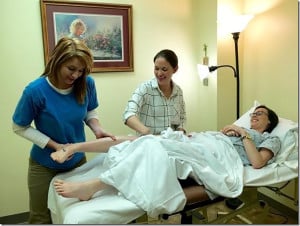Local Physical Therapist Talks About That Embarrassing Little Secret And How To Overcome It
By Lydia Crochet
When you sneeze, do you pee a little?
If so, you’re not alone; the behavior is way more common than you might think.
With all the coughing and sneezing that comes with allergy season, for some women the flu-like symptoms are the least of their worries. For them, even a good belly laugh can require a change of undergarments.
Approximately 80 percent of women will experience urinary incontinence, or involuntary loss of urine, during their lifetime. Statistics show that one of every five Americans of every age suffer from some type of pelvic problem, or “pelvic floor” dysfunction, at some point.
But many of these problems go undiagnosed. It’s a secret that no one wants to talk about.
And it doesn’t affect only women; men and children can have pelvic floor dysfunction as well.
Physical therapy is a common and effective treatment for pelvic disorders. Dr. Peter Lotze, MD, of the Women’s Pelvic Restorative Center in Houston, says, “Physical therapists have become an important component for treating complaints of incontinence and prolapse (‘dropped bladder’). PTs play a substantial role in strengthening the pelvic floor to prevent problems, as well as managing other pelvic complaints, including pain — such as interstitial cystitis or pelvic floor muscle spasm.
“As a specialist, I recognize that it is imperative to utilize a PT whose background and training remain not only up-to-date but on the cutting edge of medicine.”
Johnnie Kleinschmidt, a local physical therapist, specializes in the treatment of pelvic disorders in women, men and children. “Many people live with these problems and do not seek help, either due to embarrassment or fear of having a surgical procedure,” she says. “They do not realize that physical therapy is a successful alternative to surgery. In fact, many women who receive physical therapy are able to avoid surgery and will see a significant improvement in their symptoms.”
What Is Pelvic Floor Dysfunction?
The pelvic floor is the region at the bottom of the pelvic bones that consists of muscles, ligaments and connective tissue. These elements help support the abdominal and pelvic organs, and control bladder, bowel and sexual activity. This area also includes the bladder, vagina, uterus and rectum.
Pelvic floor dysfunction is not limited to urinary incontinence. It refers to a wide range of problems that occur when the muscles of the pelvic floor are weak or tight. The tissues surrounding the pelvic organs may have increased or decreased sensitivity or irritation, resulting in pelvic pain.
While difficulties with urination and bowel movements are common following pregnancy, childbirth, trauma (such as a fall or other accident) or surgery, sometimes these problems may be due to an infection, poor posture or insidious onset. An impairment of the sacroiliac joint, lower back, coccyx or hip joint may also contribute to pelvic floor dysfunction.
Kleinschmidt began her career as a physical therapist in 1993 after graduating from the University of Tennessee with high honors. “I’ve treated in every aspect of PT: orthopedic, in-patient rehab, out-patient rehab, acute care, wound care, pediatrics, skilled nursing facilities, home health …”
Kleinschmidt started treating pelvic dysfunction in 2001. She took her first pelvic PT class after a friend discreetly approached her, asking for help with stress urinary incontinence (leaking bladder). “I thought, ‘Hmmm, guess I’ll try this too….I’ve done everything else.’”
In 2015, Kleinschmidt continued her specialization by completing a year-long internship under Diane Lee in the Integrated Systems Model (ISM). Kleinschmidt earned her PRPC (Pelvic Rehabilitation Practitioner Certification) with the Herman and Wallace Pelvic Rehabilitation Institute.
Given that there are only a handful of PRPC physical therapists in the country, Kleinschmidt isn’t limited to seeing patients in the Lake Area. “I see patients from all over the Louisiana — some who drive several hours every week to see me. I also have patients who travel from Texas.”
“Along the east Texas/Louisiana region, Johnnie Kleinschmidt has maintained herself as the region’s leading physical therapist in pelvic floor therapy,” says Lotze. “Her devotion to not only her patients but, as well, her diligence in advancing her education in this field, have made her a highly sought-after physical therapist. [She is also highly sought-after] by physicians seeking her opinion [or] assistance. Our patients referred to her — many of whom have challenging medical conditions — ultimately go on to have exceptional outcomes.”
What Is Pelvic Floor Physical Therapy?
It is a specifically designed program of exercises, postures, massage, biofeedback, manual therapy and electrical muscle or nerve stimulation. Each patient is prescribed a treatment plan tailored to the individual to address their particular complaint. Patients will learn to relax and coordinate the movement of pelvic floor muscles.
Kleinschmidt uses several different techniques in her practice; these include visceral mobilization (the manipulation of organs) and manual orthopedic (muscle and joint manipulation) physical therapy. Kleinschmidt says, “We also use a manual technique, known as myofascial release, to help stretch and release the fascia, which is the connective tissue between the skin and underlying muscle and bones. Pelvic physical therapy is much more than just ‘Kegels.’”
Here are some prominent symptoms of pelvic floor dysfunction:
• Constipation, straining and pain with bowel movements,
• Pelvic muscle spasms,
• A frequent need to urinate or incontinence,
• Pain or pressure in the lower back, pelvis, genitals or rectum,
• Painful intercourse for women.
The best pelvic rehabilitation therapists are good orthopedic therapists first. In some cases, pelvic and abdominal pain may be a result of a musculoskeletal problem rather than a prolapsed uterus or descended bladder.
Pelvic floor physical therapy has been shown to alleviate musculoskeletal pain centered in the pelvis and lower abdomen.
During the initial evaluation, the therapist may find that the source of the pelvic pain is actually a tear in the labrum (cartilage) of the hip, which is very common in females.
Dr. Brett Cascio, an orthopedic surgeon and specialist at Lake Charles Memorial Hospital, comments on Kleinschmidt’s role in treating pelvic pain: “It is my privilege to work with her on a regular basis as part of a multidisciplinary team to address many women’s hip and pelvis problems. Because of Johnnie, our local mothers and daughters can stay home for treatments instead of traveling out of town or even out of state.
“Johnnie lives and breathes for her patients. She helps women with their most intimate and painful problems, and moves mountains if there’s even the possibility that moving that mountain will help her patient. She is a force of healing nature.”
Your symptoms could be a sign of a complex pelvic health issue, such as vulvodynia, pudendal neuralgia or interstitial cystitis. For some, the medical terminology used for these disorders are about as understandable as ancient hieroglyphics. But if you feel that something isn’t right in the pelvic area, don’t ignore it. The treatment may be simpler than you imagine.
If you experience any symptoms of pelvic floor dysfunction, pelvic physical therapy may be the answer. To be referred, you’ll need a prescription from a doctor, chiropractor or nurse practitioner. Kleinschmidt, Marianne Daigle, PT, and Mary Lynn Bounds, PTA, make up the physical therapy team at Lake Charles Memorial Hospital For Women.
“I treat the patient from the outside to the inside, helping them to change the way they live, move and experience their bodies,” says Kleinschmidt. “I’m not just treating the physical. Most people don’t realize the emotional and psychological effects of pelvic issues. These patients need validation and hope.”



















Comments are closed.